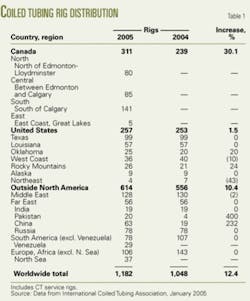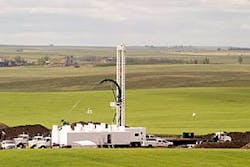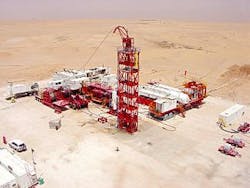Drilling Market Focus: Coiled-tubing use growing faster than drilling industry
The market is booming for coiled-tubing equipment and services for well interventions and drilling.
Coiled-tubing drilling, although only 15% of the overall CT industry, is growing faster than the CT intervention market.1 Because of its niche applications in coalbed methane exploitation, predominantly in Western Canada, the number of wells drilled with coiled tubing has increased 60%/year for the past 3 years.
Coiled tubing is used in a wide range of applications, including well intervention and workovers, production, completion, and drilling(CTD). Coiled-tubing strings can be reused (drilling, workovers) or set in place permanently (production, injection, velocity, or siphon strings).
Workover applications include clean-outs, jetting, scale removal, acidizing, hydraulic fracturing, chemical injection, spotting, fishing, and cementing. Completion applications include production strings, velocity strings, jet pumps, plungers, and ESPs.
Coiled-tubing technology has been evolving rapidly to meet the changing needs of the industry. Halliburton Energy Services Group recently announced tapered coiling tubing and BJ Services Co. announced new CT couplings.
Halliburton and BJ Services, along with Schlumberger Dowell Coiled Tubing, part of Schlumberger Ltd., supply 70% of the coiled-tubing market. Many smaller companies provide coiled-tubing services in the US (25), Canada (35), and outside of North America (30), according to the International Coiled Tubing Association.
ICoTA
The International Coiled Tubing Association is headquartered in Longview, Tex., with chapters in the Gulf Coast, Canada,2 and Europe (Aberdeen).
According to the ICoTA, there were 1,182 active coiled-tubing rigs worldwide as of January 2005, up 12.4% from 1,048 CT rigs operating a year earlier (Table 1; includes CT service rigs). The biggest fleet growth was in Canada, rising to 311 CT units from 239, a 30% increase. But only 42 of the 311 are built-for-purpose CT drilling rigs.
Only four new CT units were added to the US fleet, which stood at 257 units in January 2005. Outside of North America, the ICoTA reported 614 active CT rigs, up 58 rigs (10%) from 2004.
The SPE and ICoTA jointly sponsor an annual coiled-tubing conference in The Woodlands, Tex., near Houston. The most recent was held Apr. 12-13, 2005. Joe Winkler, chief operating officer of National Oilwell Varco, presented the keynote speech-a manufacturer’s point of view of the coiled-tubing industry.3
Winkler said the CT service industry was growing at 9%/year and was worth about $1 billion/year through 2003, based on data from the US Department of Energy’s National Energy Technology Laboratory (NETL). He said the worldwide CT unit fleet was growing at about 8%/year, compared with the worldwide drilling fleet growth at only 2%/year.
CT drilling began in 1992 and reached 500 wells/year by 1996, Winkler said. By 2003, about 1,500 wells were drilled with coiled tubing, nearly 40% of which Winkler attributes to coalbed methane drilling. In 2004, about 2,500 CT wells were drilled, more than half for coalbed methane. By the end of 2005, Winkler estimated, 3,500 CT wells would be drilled, about two-thirds for CBM.
At the March 2004 ICoTA conference, the Varco group companies (prior to the 2005 merger with National Oilwell) displayed a complete coiled-tubing unit. This included a combination land-offshore coiled-tubing unit from the Hydra Rig division; a blowout-preventer (BOP) stack from the Texas Oil Tools division; tubing created by Quality Tubing Inc.; and a data-acquisition system by Coiled Tubing Engineering Services.
Stewart & Stevenson Services Inc. displayed a state-of-the-art body load coiled-tubing rig, featuring a lightweight S&S Series 800 injector head. The unit is capable of carrying about 10,000 ft of 13⁄4-in. coil tubing with control system, BOP, crane, and all standard accessories.
With a nearly $1 billion market, there is a lot of industry attention to the use of coiled tubing in well interventions and good market potential for CTD.
Manufacturing
NOV’s Winkler told the ICoTA in April 2005 that about 35 million ft of coiled tubing were manufactured in 2004 and that manufacturing showed a 4%/year growth rate during 1996-2004.
Based on price sheets from US tubing mills, which create continuous coiled tubing from flat rolled, low carbon, high-strength steel, the price of manufactured tubing has risen nearly 10%/year for the last several years.
There are two major manufacturers of seamless steel tubing in the US:
• Quality Tubing Inc., a division of National Oilwell Varco.
• Precision Tube Technology LP, a subsidiary of Maverick Tube Corp.
Headquartered in Houston, tubing producer Quality Tubing Inc. (QT) was established in 1976 and owned by Varco International Inc. until the Mar. 11, 2005, merger into National Oilwell Varco.
QT offers five tubing product lines: the original QT-700 (70,000-psi minimum yield; QT-800 (80,000 psi); QT-1000 (100,000 psi); QT-900 (high strength, sour-service coiled tubing); and True-Taper (bias-welded tapered strings for deep wells). The company is also working on the development of QT-1200 tubing (120,000-psi yield strength). Quality Tubing supplies tubing in continuous lengths up to 26,000 ft without welds.
Quality Tubing sells coiled tubing in nine different diameters (0.75 in. through 3.5 in. OD) and gauge (WT) from 0.87-in. to 0.203-in.
QT’s delivery system allows the company to manufacture more than 90% of its orders for coiled tubing within 2 weeks of receiving an order. QT has services worldwide through subsidiaries Coil Services (North Sea) Ltd. (Aberdeen), Quality Tubing, Canada Ltd. (Red Deer, Alta.), and Quality Tubing SA Venezuela (Ojeda, Zulia State).
At the ICoTA conference in April, NOV’s Winkler pointed out the new QT-16Cr corrosion-resistant alloy tubing as a breakthrough technology.
In mid-May, Maverick Tube Corp., the largest producer of oil country tubular goods (OCTG) in the US and Canada,4 announced a $12-million expansion project at its Precision Tube Technology LP coiled-tubing facility in Houston. The project will increase capacity at the plant by 50% and be complete by first-quarter 2006. St. Louis-based Maverick Tube acquired Precision Tube on Apr. 1, 2002.
Precision Tube began producing tubing in 1990 and claims to be the first tube mill in the world to achieve ISO 9001 certification. The Houston facility holds two world manufacturing records, producing:
• The longest continuously milled coiled-tubing work string: 30,200 ft of 2-in. diameter coiled tubing.
• The heaviest continuously milled coiled-tubing work string: 92,720 lb of 23⁄8-in. coiled tubing (HS80).
Precision Tube sells CT in 10 different diameters (1-in. through 4.5-in. OD) in a range of gauges (WT) from 0.08-in. (1-in. diameter CT) to 0.25-in. (4.5-in. diameter CT).
The tubing ranges in weight from 0.79 lb/ft (0.08-in. gauge, 1-in. diameter) to 11.38 lb/ft (0.25-in. gauge, 4.5-in. diameter). Material grades include HS-70, HS-80, HS-90, and HS-110.
Beginning on Mar. 1, 2005, Precision Tube increased coiled-tubing prices by 9.1% due to “escalating costs.” The company had previously increased prices by 9% in August 2004 and by 8.2% in May 2002.
Precision Tube operates a service and testing facility in Red Deer, Alta. (Precision Tube Canada Ltd.), and an office in the UK (Peterhead Scotland facility).
CT in Canada
According to the Canadian chapter of the ICoTA,2 coiled-tubing equipment manufacturers in Canada include: Crown Energy Technologies; Enerflow Industries Inc.; and Hydra Rig NOV.
Privately held Crown Energy manufactures CT units primarily for hydraulic fracture applications. The company is based in Calgary and currently builds its CT units there but may begin building CT rigs at its Victoria, Tex., facility. (Crown purchased Victoria Machine Works in early 2005.) Crown Energy has about 1,000 staff in Canada and the US, after adding about 300 in Alberta since March 2005.
Doug Reder, Crown Energy account manager in stimulation, told OGJ that since 2001, the company has built 12 trailer-mounted CT service rigs for Schlumberger; Halliburton; Evergreen Resources Inc. (acquired by Pioneer Natural Resources Co. in Sept. 28, 2004); and CalFrac Well Services Ltd. All the rigs are working in Canada.
Crown Energy built a single truck-mounted CT unit for Calgary’s Enecal Canada Corp. for work in Kazakhstan, and one skid-mounted helicopter CT service rig. The company is currently building six new trailer-mounted CT units for Technicoil Corp. in Calgary; the first will be complete in September. Technicoil already runs a fleet of 12 standard, self-propelled CT rigs and 2 trailer-mounted “new generation” CT rigs.
Reder said it takes about 5,000 hr to build a trailer-mounted CT unit, and the cost can run up to $2 million (Can.) with a support unit (BOP, lubricators, chassis-mounted tractor). Truck-mounted and skid-mounted units can be built in about 3,500 hr and can cost as little as $1 million (Can.). In Canada, most of the CT service rigs are running 27⁄8-in. tubing with gel and sand proppant for fracs. Coalbed methane work is increasing, he said; CBM fracs are done with nitrogen (no foam, no proppant).
CTD in Canada
Calgary-based Precision Drilling Corp. and Trailblazer Drilling Corp. (a wholly owned subsidiary of Savannah Energy Services Corp.) dominate the CT drilling market.
Precision has 10 regular CTD rigs and one “supercoil” CTD rig (814CT) rated to 2,000 m.
Trailblazer Drilling has 26 hybrid CTD units (up from 13 rigs in early 2004) working in the Western Canada Sedimentary Basin, including 25 first-generation hybrid rigs (CT1500) capable of drilling to 1,500 m with 27⁄8-in. coiled tubing or 1,200 m with 31⁄2-in. drill pipe; and one second-generation hybrid (CT2200) capable of drilling to 2,200 m deep with 31⁄2-in. coiled tubing or drill pipe. Trailblazer has seven additional first-generation hybrid CTD rigs under construction, with delivery anticipated first-quarter 2006.
In its second-quarter 2005 results, released Aug. 5, Savannah Energy said that its contract drilling day rates had increased 38% over the same period in 2004. Canadian day rates average about $14,000 ($12,000/day plus $2,000/day for “coil charge” and mud).1
In November 2004, Calgary-based Ensign Resource Service Group Inc. announced construction of 10 state-of-the-art ADR-1000-CT rigs (automated drill rigs-coiled tubing). The hybrid rigs incorporate Ensign’s unique coil-over-table design, which can more easily manipulate larger tubing diameters, such as 31⁄2-in., as well as standard jointed drill pipe.
The first new rig was unveiled on May 18, 2005, in Calgary, according to an Ensign press release. Three of the 10 planned rigs entered the Canadian market by the end of June 2005, according to the company’s second quarter results, released Aug. 8.
Calgary-based Enerflow Industries has built two coiled-tubing drilling rigs. Company directors Mark Williamson and Larry Lindholm told OGJ they completed their first CTD rig in August 2004 and it’s capable of drilling to 1,000 m (Fig. 1). After testing in Alberta, the single-phase (compressed air) rig has been in continuous operation for the owner-operator in the US.
Enerflow designed a dual-phase CTD rig, capable of drilling with mud or compressed air to about 1,500 m, and this second rig was to be completed in early September 2005. The company is now in negotiations to build a third CTD rig and reports high interest from the US, Australia, and the Russian Federation.
Hydra Rig NOV is a division of National Oilwell Varco’s coiled-tubing drilling products group. In addition to CT service units. Hydra Rig manufactures coiled-tubing drilling rigs, including a multipurpose CTD system. At the ICoTA conference in April 2005, Winkler discussed the new Hydra Rig 600 series injectors. He pointed out they were 20% lighter weight and featured quick connect grippers. The timing gear was eliminated and the overall number of parts reduced.
Randy Graves, Hydra Rig’s vice-president of sales and marketing told OGJ that about 10 of the 600 series injectors are in the field so far, with another 10 that will be ready before the end of the year. Graves said it took 21⁄2 years to develop the new 600 series and he anticipates building as many as 400 units over the next 5 years. There are three different models:
• HR6365 (35,000 lb of pull).
• HR660 (60,000 lb of pull).
• HR680 (80,000 lb of pull).
Graves said they are seeing cleaner pulls and better grip with minimal slippage with the new injectors, as well as increased chain life (five times that of older style heads), which should reduce maintenance costs and down time.
The coiled-tubing fleet is aging. Although 40-50 units are built each year, at least 60% of those replace older units. Graves said the fastest way to upgrade an existing CT unit is to replace the injectors, and he anticipates a large market for injector upgrades.
Graves said NOV builds 60-75% of the overall CT units worldwide, and Hydra Rig’s Calgary facility produces 30% of the worldwide CTD rigs.
Hydra Rig built the first CTD unit for Surgutneftagaz in Surgut, west central Siberia. It was commissioned and put into service earlier in 2005 and had drilled 12 wells as of August. Mike Hoyle, NOV’s vice-president of sales and marketing for CT and wireline said that Surgutneftagaz considers the project a success. CTD technology is suitable to Siberia because there are no overhead restrictions or road weight limits for the rigs and equipment.
Hydra Rig also has 34 new electrically controlled CT units. In the Canadian market, virtually all of the units are electrically or hydraulically controlled; some have computer systems. Electrically controlled systems are preferred in Canada because hydraulic systems do not perform as reliably in cold temperatures. Outside of Canada, hydraulically controlled systems predominate, Graves said.
ICoTA lists ten coiled-tubing service companies operating in Canada: BJ Services; Coil Tubing Completions Ltd.; Cubex Ltd.; Halliburton; Joule Technical Sales Inc.; Midwest Coiled Tubing Services; Sanjel; Schlumberger Well Services; Tartan Controls Inc.; and Trican Well Service Ltd.
BJ Services has carried out more than 285 underbalanced horizontal CTD operations in Canada, and nearly 1,000 vertical underbalanced well deepenings with coiled tubing through 2004.5
Calgary-based Sanjel is a privately held international oilfield services company that designs and manufactures conventional, intermediate, and multipurpose (330, 660) coiled-tubing units. The company provides tubing from 1-in. to 27⁄8-in. diameter.
CTD in the US
Most CTD rigs are limited to relatively shallow drilling and only a handful of CTD rigs are working in the US. Deeper wells require larger diameter tubing, wrapped around a larger spool to prevent fatigue, and the spool weights can easily exceed US Department of Transportation limits.
BP PLC is using coiled-tubing drilling in the Anadarko Basin and on Alaska’s North Slope. In August, Joe J. Melvan vice-president at Orbis Engineering Inc., reported on BP’s experiences with CTD.6 Orbis has been involved in BP’s CTD programs since 1995.
Melvan said that sidetracking through existing 31⁄2-in. or larger tubing “provides the major cost savings” over conventional operations that would require tubing removal and that a multiwell campaign is usually essential for CTD to be economical.
BP has drilled more than 500 wells in Alaska using coiled tubing since 1992 at an average cost of $1.5 million/well. Drilling an average of 400 ft/day, BP completes each CTD well in about 2 weeks. Melvan said that about 400 sidetracks were drilled through or below 41⁄2-in. tubing (with a 33⁄4-in. bit) and 100 sidetracks were drilled through or below 31⁄2-in. tubing (with a 23⁄4-in. bit). All sidetracks were drilled overbalanced, but BP is planning underbalanced CT drilling in the Lisburne carbonate and the tight Sag River sandstone.
In 2004, BP drilled a world record CTD well in Alaska’s Niakuk field (17,515 ft). The company also set two Alaskan horizontal drilling records:
• 3,214 ft with a 33⁄4-in. bit.
• 2,687 ft with a 23⁄4-in. bit.
BP’s CTD operations in the Anadarko basin are centered on the Cleveland tight gas project in the northern Texas Panhandle. The goal is to reduce costs in a mature gas field. The project involves reentering wells with existing 23⁄8-in. and 27⁄8-in. tubing, pulling the tubing, drilling horizontally 1,500 ft or farther with 27⁄8-in. or 31⁄2-in. tubing and fracturing the wells.
The project began in August 2005 with a new CTD rig designed by Denton, Tex.-based Procoil Coiled Tubing Services, a subsidiary of Parchman Energy Group Inc., which merged with Integrated Production Services Inc. in February 2005. The rig can drill to 7,000 ft with a lateral or multilaterals up to 3,000 ft.
Procoil’s Steve Graham told OGJ the rig was built by Hydra Rig in Fort Worth and has a Hydra Rig 580 injector. The company has had it for 3-4 years, and it has been drilling predominantly in Texas.
The Petroleum Technology Transfer Council, an industry-directed 501-C-3 organization, is following the Anadarko basin CTD project closely since it involves drilling out of 41⁄2-in. casing (a core technology development area for the DOE microhole program), according to NETL’s Roy Long. PTTC will publish the results on its website.
The DOE is sponsoring field tests of a new zero-discharge CTD rig developed by Advanced Drilling Technologies LLC (Fig. 2). The CTD rig handles 1-in. to 25⁄8-in. coiled tubing as well as 75⁄8-in. R3 casing and has a 5,000-ft depth capability with 1,000 ft lateral. The trailer-mounted rig can be moved in only four loads and has a zero-discharge capacity mud system.
ADT’s Tom Gipson told OGJ that they are using the rig to drill in the Niobrara gas area: 17 wells in 2004, as well as 27 wells in western Kansas and 113 so far in northeastern Colorado in 2005.
US CT market
Based on data from ICoTA, regionally, South Louisiana has the greatest number of CT rigs (58), 23% of the nation’s coiled-tubing fleet. South Texas has the next greatest activity (44 rigs), 17% of the US rigs. The remaining 60% of the US fleet is found in East Texas and the West Coast (36 rigs, 14% each), Rocky Mountains (26 rigs, 10%), Oklahoma (25 rigs, 10%), West Texas (19 rigs, 7%), Alaska (9 rigs, 4%), and the Northeast (4 rigs, 2%).
In July 2005, the Weatherford-AESC well-service rig count rose by six to 2,347 in the US. Utilization is at 69%. The count is 8.7% higher than its year-ago total of 2,106. It is unclear what percentage of these are coiled-tubing units.
ICoTA data show that the top six coiled-tubing contractors in the continental US account for 74% of all the active rigs. Schlumberger Ltd. (43 CT rigs) and BJ Services Co.’s CoilTech division (42) lead; followed by Halliburton (37); Cudd Pressure Control Inc., a wholly owned subsidiary of RPC Inc. (26); Superior Coiled Tubing, part of Superior Energy Services Inc.’s well intervention group (21); and Coiled Tubing Services (20).
Regionally, BJ leads in East Texas, running 10 of the 36 active CT units, and in Oklahoma, running 8 of the 25 active CT units.
In South Texas, BJ and Coiled Tubing Services are tied for the lead, with 8 CT rigs each, representing 36% of the 44 active rigs. They are followed closely by Schlumberger (6); Superior (5); Arctic Recoil Inc. (4); and Halliburton Coiled Tubing (4), representing another 43% of the South Texas market.
In April 2005, Spring, Tex.-based Grifco International Inc. announced its acquisition of Houston-based Coil Tubing Technology Inc. The companywas founded in 1998 and specialized in designing proprietary tools for the coil-tubing industry. The CTT jet motor is a downhole drilling motor that can operate on coiled-tubing workover units in fluid or nitrogen wells up to 600° F.
In June, Grifco announced that it would begin shipping the first of 50 jet motors from its Louisiana production facility in July. The company said each jet motor could generate rental fees of more than $50,000/month. Grifco also announced that it plans to expand into the Canadian CT market.
Grifco’s Jim Dial told OGJ in early September that the first 50 jet motors were sent to locations in the US and Mexico. Another 50 will be sent worldwide in October.
CT outside North America
Calgary-based CalFrac Well Services Ltd. announced in June that it has long-term contracts with Moscow’s OAO Sibneft for two deep coiled-tubing units with nitrogen and fluid pumping equipment in western Siberia. Doug Ramsay, CalFrac’s president and CEO, told OGJ that the first rig had arrived in Noyabrisk, western Siberia, by mid-August and the second was en route by train from St. Petersburg. The rigs were upgraded with more powerful pumping equipment and longer tubing reels, allowing to reach 4,000 m and deeper.
CalFrac ordered three new trailer-mounted CT units from Hydra Rig in Fort Worth to replace the ones sent to Siberia. The new rigs will be in Canada by October.
BJ Services Coiled Tubing Research & Engineering group in Calgary has been in the forefront of CTD developments for on and offshore. After drilling more than 260 wells in Canada with its technology for drilling using coiled tubing (DUCT), BJ drilled three underbalanced wells in two onshore fields in the Netherlands in 2003.
BJ drilled two wells in the Coevorden field for Nederlandse Aardolie Maatschappij (NAM), a Royal Dutch Shell PLC-ExxonMobil joint venture, using DUCT. Engineers drilled 3,458 ft underbalanced using KCl brine and nitrogen, including two laterals, during the 51-day operation.7
BJ next used DUCT to drill a single well in the Emmen field, again for NAM. BJ’s Alasdair Buchanan said the tests were especially significant because they could “deploy the BHA under pressure in a safe, efficient manner, which is critical when drilling underbalanced, and especially so when drilling underbalanced in the presence of H2S gas.”7
Beginning in late 2004, BJ Services supplied coiled-tubing drilling, engineering, and solids control services for two Shell UK wells on the Gannet platform in the Central North Sea. Shell is interested in dynamic annulus pressure controlled (DAPC) CTD from the Gannet Alpha platform, discussed in a presentation at a drilling conference in June 2005.8
BJ is working on new technology to facilitate coiled-tubing drilling offshore, where the weight of coiled-tubing reels often exceeds the crane’s lift capacity. At a conference in June 2005, engineers from BJ, Statoil ASA, and ConocoPhillips Norway discussed the new LCF (low cycle fatigue) spoolable connector, which replaces offshore butt-welding and resolves the weight issues with CT reels.9
Halliburton’s Energy Services Group has been providing underbalanced CTD services for BP Amoco Sharjah Oil Co.’s Sajaa field in the United Arab Emirates. The contract was extended for 2 years in March 2004 and will expire in 2006. BP’s drilling program included up to three multilaterals/well to be drilled underbalanced through tubing from existing wells.10
Future
Results from the UBD program in the Sajaa field will be presented at the International Petroleum Technology Conference in Doha, November 2005. Authors from Schlumberger, BP Sharjah, Baker Hughes INTEQ, and Halliburton will discuss 27 wells, 90 laterals, and more than 212,000 ft drilled with underbalanced coiled-tubing drilling.11
Weatherford is about to begin an underbalanced CTD pilot project for Sonatrach in Hassi Messaoud, Algeria’s largest oil field. Weatherford purchased a CTD rig from Baker Oil Tools earlier this year and immediately upgraded the power pack, reel, drill console, and injectors. The Hydra Rig HR5100 unit can now pull 100,000 lb and is equipped with 27⁄8-in. tubing from Quality Tubing (Fig. 3).
Chevron Corp., Statoil, and the DOE are sponsoring experiments with composite coiled tubing (with embedded fibers for communication) and a riserless drilling system to drill low-cost deepwater wells. Geoprober Drilling Inc. designed a new subsea system (seabed anchor and shutoff system) and has an option to purchase the Anaconda CT equipment from Halliburton. Geoprober will drill three demonstration wells:
• Land well, potentially Catoosa.
• Subsea, potentially in the Gulf of Mexico.
• Deep water; Geoprober estimates a 59% savings over the cost of a conventional Gulf of Mexico exploration well drilled from a semisubmersible.
There are a myriad of applications for coiled tubing. Rapidly becoming mainstream technology in Canada, CTD stands to shine in the US market as well as outside of North America. ✦
References
1. Rychel, D., “Coiled Tubing: State of the Industry and Role for NETL,” Topical report, June 2005, 32 pp.
2. www.icota-canada.com
3. Winkler, J., “The Coiled Tubing Industry: A manufacturer’s point of view,” SPE/ICoTA Coiled Tubing Conference, The Woodlands, Tex., April 2005; www.icota.com/publications
4. Simmons & Co. International, “The OCTG Markets: Well Positioned for Volume and Pricing Growth During 2005 and 2006,” Energy Industry Research Report, June 29. 2005.
5. BJ Services press release, November 2004.
6. Melvan, J., Johnson, M.O., and Odenthal, R.S., “BP Coiled Tubing Drilling Experiences,” Aug. 17, 2005.
7. BJ Services press release, Jan. 9, 2004.
8. Laird, A., McFadzean, K., Edgar, J., and Harty, I., “Offshore Implementation of Through Tubing Dynamic Annulus Pressure Controlled (DAPC) Coiled Tubing Drilling,” IADC World Drilling 2005, Rome, June 9-10.
9. Laun, L.E., Link, L.R., Nesvik, K.T., and Boge, H. “Large Diameter Coiled Tubing Becomes Available Safely Offshore Through a Newly Developed Spoolable Connector: Case Histories and Field Implementation,” IADC World Drilling 2005, Rome, June 9-10.
10. Suryanarayana, P.V., Smith, B., Hasan, ABM, et al., “Basis of Design for Coiled-Tubing Underbalanced Through-Tubing Drilling in the Sajaa Field,” SPE 87146, 2004 SPE/IADC Drilling Conference, Dallas, Mar. 2-4.
11. Kavanagh, T., Pruitt, R., Reynolds, M., et al. “Underbalanced Coiled Tubing Drilling practices in a Deep, Low-Pressure Gas Reservoir,” IPTC 10308, International Petroleum Technology Conference, Doha, Nov. 21-23, 2005.





